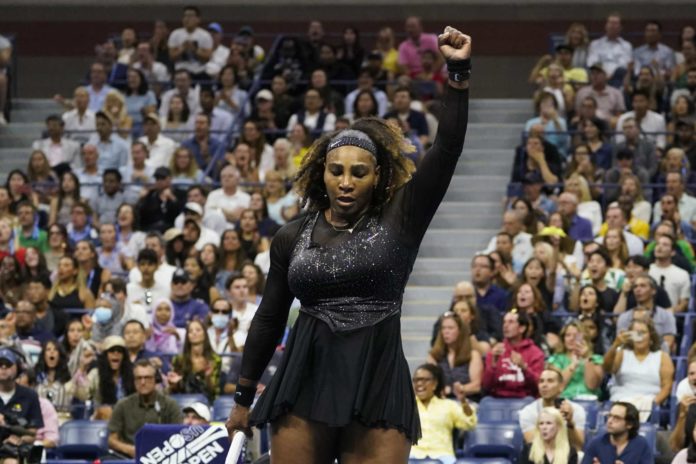
It’s rare that a major sporting event becomes more about perspective than performance. Such is the case with the U.S
. Open tennis tournament, a joyous and touching celebration of Serena Williams’ global influence.
She departed with a scoreline that didn’t look impressive: a 7-5, 6-7 (4), 6-1 third-round loss to Ajla Tomljanovic, a young Australian from Croatia who steeled herself for the occasion and performed magnificently. But it was a glorious departure all the same, rich in thunderous cheers, standing ovations for Serena and a moving, emotional speech.
There’s only one Mount Rushmore in this world, but now that we’ve savored the spectacle of sellout crowds filling the National Tennis Center, with millions of people attuned to Serena’s must-see television, it’s time for a sequel — one all about women’s sports for those who truly made a difference.
The list of great athletes is so expansive as to run right off the page. Such names as Jackie Joyner-Kersee
, Cheryl Miller, Mia Hamm
, Sue Bird, Steffi Graf
, Simone Biles and Marta, the Brazilian soccer icon, quickly come to mind. If you force me to narrow it down, my personal Mount Rushmore of women’s athletics consists of Williams, Billie Jean King, Martina Navratilova and Babe Didrikson Zaharias
.
In clear violation of the rules — Rushmore allows for just four people — I’m adding Venus Williams because Serena’s story cannot be told without her. “The only reason Serena Williams ever existed,” the little sister told the crowd Friday night through her tears.
It’s remarkable to watch King roam the grounds of the U.S. Open, Wimbledon, or anywhere else where the cause for social justice needs a little push. At 78, she remains a magnet for female athletes of all ages, eager to absorb the presence of a legend and witness her tireless pursuit of equality, inclusion and diversity.
She was 13 when she came upon the very white and male-dominated world of of tennis and thought to herself, “Where’s everyone else?” There were no collegiate athletic scholarships offered to women, and there was no such thing as a professional tennis player. Dynamically successful on the court, rising to No. 1 in the world with a scintillating brand of all-court play, she worked behind the scenes to organize the first women’s pro tour (1970), found the Women’s Tennis Association (1973), help convince the U.S. Open to offer equal prize money to the male and female winners, and launch the Women’s Sports Foundation (1974).
But it was a single night in 1973 that really snared the world’s attention. Bobby Riggs, a known hustler still working the angles at 55, had challenged top-ranked Margaret Court to play an exhibition match — and won. King knew Riggs was no slouch — he was once No. 1 — but she also knew she had to play him. It seemed bizarre and a bit unseemly, but this would connect to social change, a chance to make a grand statement on behalf of women so terribly tired of chauvinistic nonsense.
It would be a five-setter but King dispatched the man in straights, before a worldwide TV audience of more than 90 million people. The spectacle became an iconic moment of pop culture and Riggs took it well, knowing its impact went so far beyond the scoreboard.
Move ahead to 1975 and picture Navratilova, 18, about to defect from communist Czechoslovakia. It was a brand of courage she would need in America, where there wasn’t much support for an overweight (“lumpy,” as she recalled) immigrant known to be gay but reluctantly closeted in a world rife with homophobia.
The thing was, she could
really
play, winning both the Australian Open and French Open that year, and she was fearless. She spoke out against injustice in her native land
and
new home, eventually doing so in a crisp and refined brand of her second language. She launched a training program of such dedication, she emerged with a sculptured, muscular physique that, though scorned and discounted at the time, became a template for female athletes’ training around the world.
Looking back, people realize that Navratilova, like King, played the most dazzling version of tennis, a veritable dance of artistry, creativity, daring rushes to the net and decisive volleys. As much as she is remembered for her championships and longevity, equally relevant was a change-the-world mentality that made her a decidedly polarizing figure.
In 1981, now openly gay and the first legitimate superstar to come out while she held such status, Navratilova traveled the world with her companions and, during her marriage to Judy Nelson, stationed her quite prominently in the player’s boxes. (Not exactly what the TV networks had in mind.) She radically hired a transgender woman, Dr. Renee Richards, for her coaching and training, and they worked together during two of Navratilova’s Wimbledon championships. In recent years, though, she has drawn harsh criticism for advocating trans women to be barred from competing in women’s sports.
She knew from her teenage years that she might never be fully accepted, and that her convictions could cost her millions in sponsorship and endorsements. She nevertheless forged ahead.
Mildred “Babe” Didrikson Zaharias cannot be excluded for this simple reason: Even as she comes from a different time, reaching her peak during the Great Depression days of the 1930s, she is remembered as unquestionably the greatest female athlete of them all.
Raised as the daughter of Norwegian immigrants in the heart of Texas, standing just 5-foot-5 but sturdily built and flamboyantly confident, Didrikson was accomplished in basketball, track, golf, baseball, tennis, swimming, diving, boxing, volleyball, handball, bowling, billiards, skating and cycling.
Among her countless feats of prominence: gold medals in the high jump, javelin and 80-meter hurdles at the 1932 Los Angeles Olympics; winning 55 tournaments in amateur golf, including the British Amateur and U.S. Women’s Open; earning AAU All-American honors in basketball; traveling the country with a barnstorming baseball club, and becoming the first woman to play for a major-league team, pitching in various locations for the Philadelphia Athletics in spring training.
“She is beyond all belief until you see her perform,” famed sportswriter Grantland Rice wrote. “Then you finally understand that you are looking at the most flawless section of muscle harmony, of complete mental and physical coordination, the world of sport has ever seen.”
Shift to the present, and the definition of a complete, meaningful career. Serena Williams’ impact has been well chronicled, and it’s all coming together, the victories and the adulation and, more than anything, the quality that binds together these Mount Rushmore women: passion. Knocking down the obstacles that seem impenetrable. She is an athlete for her past, for now, and forever.
Bruce Jenkins writes the 3-Dot Lounge for The San Francisco Chronicle. Email: jenksurf@gmail.com Twitter: @Bruce_Jenkins1








